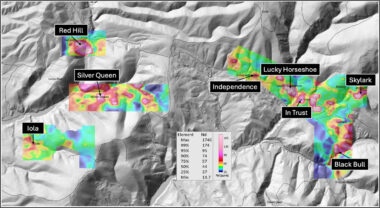The first half of 2024 was stronger than had been expected in global beef markets, with record production, export and import volumes in certain key countries, Rabobank says its recently-released Global Beef Quarterly.
Meanwhile, Australian beef production has remained high and exports hit new records as cattle prices have started to lift, the agribusiness banking specialist says in the quarter three report.
Report lead author, RaboResearch senior animal proteins analyst Angus Gidley-Baird said beef markets had seen record production and exports in Brazil in quarter two, while China had a record volume of imports in the first half of the year. Production volumes in the United States were higher than expected and prices in Europe had remained “remarkably strong”.
Looking forward, the report says, beef markets are waiting for signals of what is expected to unfold – most significantly a contraction in US production, improved cattle prices in Brazil and a possible reduction in consumption in the US following both the end of summer grilling season and persistent high beef prices.
Cattle prices continue on different trajectories across markets, with North American prices remaining at elevated levels and southern hemisphere prices – while still at significantly lower levels than the US –showing some signs of life, although Brazil’s prices have drifted lower.
Global production
Global beef production looks set to lift slightly in quarter four compared with quarter three, before falling into 2025, Rabobank says.
“Year on year though, higher production volumes in Australia expected in quarter four 2024 (up four per cent on quarter three 2023) do not offset declines in Europe (- one per cent), New Zealand (- seven per cent), Brazil (- three per cent), the US (- five per cent) and China (- two per cent),” Mr Gidley-Baird said.
Notwithstanding these declines, global beef production in quarter four is still expected to be 3.8 per cent higher than the 10-year average.
“We then expect it will contract, mainly due to lower production volumes in the US and Brazil,” Mr Gidley-Baird said.
Changing face of Chinese consumption
China – the world’s largest beef importer, taking 34.6 per cent of total global trade in 2023 – has dominated global markets for the past five years, the report says.
But now, slowing economic growth and a declining population is seeing changing consumer trends in China which are impacting the beef product mix.
“The Chinese beef market still has ample growth potential, given per capita consumption is lower than other developed Asian countries,” Mr Gidley-Baird said. “However, new consumer trends are emerging which will change consumption. Overall the premiumisation trend is slowing and consumers are pursuing both quality and value.”
He said while Chinese consumer markets showed a clear trend for pursuing value for money, consumption of beef was still growing, “albeit soft prices suggest more sensitivity to expensive cuts”.
“Rising beef consumption volumes, despite slower income growth in China, show consumers there are continuing to seek higher-quality proteins, but at reasonable prices,” he said.
“Currently, retailers and food service operators in China are under pressure to deliver cheap and basic cuts – such as shin, shank and belly – and good-value cuts at discounted prices. Chinese consumers have shifted to fundamental values – such as cost, taste, nutrition and dining experience – while the interest in luxury products, such as wagyu, have declined.”
The report says China imports a wide range of beef products from numerous countries, which are distributed through a variety of channels to different markets.
“Generally Chinese consumers have a higher acceptance of beef in frozen form compared with other meats, making imported beef easily distributed through retail channels,” Mr Gidley-Baird said.
“Imported beef has a cost advantage, while locally-produced beef meets specific needs for fresh meat, such as hot pot in southern China.”
The current trend for ‘value for money’ in China gave South American beef suppliers a clear competitive advantage in low to medium-end markets, while products from Australia and the US held a position in medium to high-end markets, he said, although all producers were currently seeing lower prices than a year ago.
Australia
Production volumes and exports remain strong for Australian beef, the report says.
Seasonal conditions continue to be favourable in most cattle-producing areas of the country, Mr Gidley-Baird said.
“Dry conditions in southern areas in the first half of the year have limited the numbers of heavy finished grass-fed cattle, but good seasonal conditions in the north continue to support high slaughter numbers,” he said. “Weekly Australian cattle slaughter numbers remain around 140,000 head per week, up 20 per cent on the five-year average. Given our expectations for the number of cattle in the system, we believe slaughter numbers will continue at these rates into the latter part of the year.”
The report says Australian beef export volumes in July this year (of 129,998 metric tonnes swt) were the largest volumes ever exported, passing previous peaks in 2019 and 2015.
Mr Gidley-Baird said Australian beef export volumes to the US for July 2024 were the highest since December 2015 and to Japan, the highest since March 2020. However volumes to China were down.
The report said Australian cattle prices rose sharply in July, particularly finished steer and cow prices, which lifted 15 per cent and 32 per cent respectively in the month. ”Prices have since levelled off a little, but remain on an upward trajectory,” Mr Gidley-Baird said.
If US import prices peaked again in quarter four – as was a typical pattern – Rabobank would expect to see Australian cow and finished steer prices creep up further.
“However, the continuing high volumes of cattle in the market and what we believe to be a steady state of high cattle inventory leads us to expect that restocker/young cattle prices will remain firm, but not see as much upside,” he said.
<ends>
Please refer to RaboResearch disclaimer: Disclaimer (rabobank.com.au)
Media contacts:
Denise Shaw Will Banks
Media Relations Media Relations
Rabobank Australia & New Zealand Rabobank Australia
Phone: 02 8115 2744 or 0439 603 525 Phone: 0418 216 103
Email: [email protected] Email: [email protected]
About us:
Rabobank Australia & New Zealand Group is a part of the international Rabobank Group, the world’s leading specialist in food and agribusiness banking. Rabobank has more than 125 years’ experience providing customised banking and finance solutions to businesses involved in all aspects of food and agribusiness. Rabobank is structured as a cooperative and operates in 38 countries, servicing the needs of more than nine million clients worldwide through a network of more than 1000 offices and branches. Rabobank Australia & New Zealand Group is one of Australasia’s leading agricultural lenders and a significant provider of business and corporate banking and financial services to the region’s food and agribusiness sector. The bank has 90 branches throughout Australia and New Zealand.



